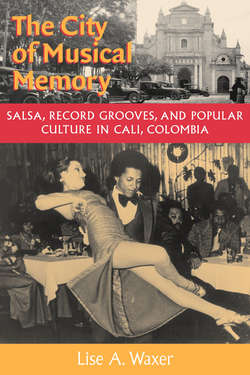Читать книгу The City of Musical Memory - Lise A. Waxer - Страница 17
The City of Musical Memory
ОглавлениеDuring the twentieth century, Cali grew from a minor town into Colombia’s second largest and second most powerful city. Several ruptures and struggles framed the city’s rise. As an elaborate archive of personal memoirs entitled Recuerdos de mi barrio (Memories of My Barrio) testifies, Cali’s sudden growth encompassed the mushrooming of new neighborhoods, the remodeling of the city center and the concomitant destruction of historical buildings, and—most vividly—the struggles of new citizens to find work, build homes, and win battles over running water, electricity, sewage, and paving for their streets (Recuerdos 1986).26 These are among the transitions that accompanied Cali’s transformation into a modern urban center. The rise of Cali’s recent urban culture—based on a new musical style adopted from abroad—points to a process of creative self-production among Caleño citizens as they strove to anchor their experiences of these tumultuous changes (Harvey 2000: 159).
The organization of this book, which documents and analyzes key stages in the emergence of salsa culture in Cali, is roughly chronological. I focus on the rise of Cali’s self-image as a world salsa capital and the ways in which this development is interwoven with deeper notions about Cali as the city of musical memory. My study traces three important spheres that encompassed Caleño popular culture by the early 1990s, each with a particular performative tradition, each with its own particular roots and routes back through Cali’s recent history, and each with a particular way of enacting the process of surrogation (Roach 1996) in local popular memory. I then draw these chapters together by exploring how these three spheres, or “scenes” (Straw 1991), come together in the most visible and exciting public event in Caleño life—the annual Feria.
Chapter 1 sets the general stage for my narrative. In it I outline Cali’s history in regional and national contexts, discuss the links between music and region in Colombia, and trace the general rise of música antillana in three overlapping spheres: the transnational (Latin America), the national (Colombia), and the local (Cali). The relationship of música antillana to the rise of Colombian música tropical—“tropical music” from Colombia’s own Caribbean coast—during the 1940s and 1950s is analyzed with regard to Cali’s relationship to national culture. Here I try to consolidate the complex historical reasons for Cali’s adoption of salsa and música antillana over and above regional and national musical styles.
In chapter 2 I focus on the rise of Cali’s record-centered dance scene as the first instance in which sound recordings were literally incorporated into local popular culture. I explore the routes via which recordings first entered Cali and how they acquired the cosmopolitan associations that entrenched their centrality in local expressive practices. The flowering of salsa dance culture in the 1960s and 1970s gave birth to a distinctly Caleño style of dancing to salsa—unique in Latin America and famous throughout Colombia. The revival of this scene in the viejotecas that mushroomed after the fall of the Cali cartel in 1996 points to a highly significant process of reactivating record-centered dance in local popular culture and memory.
The emergence of salsotecas and tabernas in the 1980s as public spaces for listening to records of salsa and música antillana points to another trajectory of local popular life that branched out from the record-centered dance scene. In chapter 3 I look at the development of the salsoteca scene in record collecting, a significant practice in local popular culture, and the rise of the melómano, or music aficionado, in Caleño life. In this sphere Caleño identity has become strongly tied to discourses about preservation, history, authenticity, and purity, in which record collections and salsotecas are constructed as vinyl museums for the active maintenance of Cali’s musical roots.
The third sphere of popular culture, and perhaps the one that succeeded best in placing Cali on the international salsa map, was the rise of a bustling live music scene in the 1980s and early 1990s—the subject of chapters 4 and 5. In a mere decade, dozens of local salsa bands were formed, with a frenzy that mirrored the invention of salsa dance steps a generation earlier. Internationally famous Caleño orquestas such as Grupo Niche and Guayacán emerged during this period, and lavish marathon salsa concerts became a key attraction of the annual Feria. While the rise of a live scene might suggest that real musicians had finally come to replace sound recordings in local popular culture, Cali’s live scene was indelibly marked by the centrality of recordings in other spheres, in ways that complicate the relationship between live and mediated musical expression.
In chapter 6 I explore the ways in which dancing, listening, and live music coalesce as performative practices during Cali’s annual Feria. This annual celebration, heightened by its calendrical proximity to two other important celebrations, Christmas and New Year’s, is a vivid reaffirmation of Caleño popular culture. As in other carnival celebrations, the tensions, paradoxes, and contradictions of daily life are revealed and embraced in a transgressive revelry (Stallybrass and White 1986) centered around salsa music. If “Cali Is Feria,” as a local salsa song put it, Cali’s Feria is salsa, in a vociferous, joyous and kinetic commemoration of salsa and música antillana that lies at the heart of local popular life.
As interrelated spheres, dancing, listening, musical performance, and the Feria are deeply embedded in Caleño subjectivity. In the following chapters I look at the ways in which public space, cultural topographies, kinetic movements, and other activities have framed these scenes, embedding physical and bodily locations for popular memory. The strands of this social history are taken up in the epilogue, where the themes of transnational culture, cosmopolitan identity, and urban life in Latin America are drawn together.
